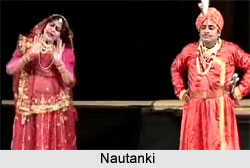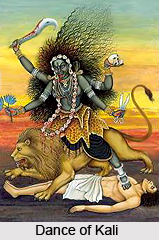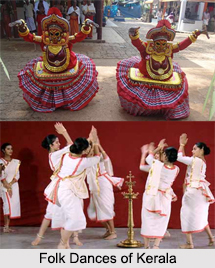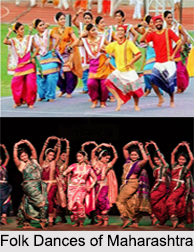 Use of language in Nautanki forms an essential part of in transforming ideas into scripts. Since Nautanki is a north Indian folk theatre form, so the language used is predominantly Hindi. Within this variety of forms, Nautanki belongs to the set of theatres whose historical evolution has been quite recent. These theatres rely on spoken vernacular languages that developed only several hundred years ago. Nautanki employs the languages based on the Khari Boli dialect, a form of speech that probably took linguistic shape during the eighteenth century in the Delhi and Meerut districts in the Indian state of Uttar Pradesh. Its written form emerged in the nineteenth century, and it now possesses two literary variants, Hindi literature and Urdu literature, the official languages of India and Pakistan respectively (together with English).
Use of language in Nautanki forms an essential part of in transforming ideas into scripts. Since Nautanki is a north Indian folk theatre form, so the language used is predominantly Hindi. Within this variety of forms, Nautanki belongs to the set of theatres whose historical evolution has been quite recent. These theatres rely on spoken vernacular languages that developed only several hundred years ago. Nautanki employs the languages based on the Khari Boli dialect, a form of speech that probably took linguistic shape during the eighteenth century in the Delhi and Meerut districts in the Indian state of Uttar Pradesh. Its written form emerged in the nineteenth century, and it now possesses two literary variants, Hindi literature and Urdu literature, the official languages of India and Pakistan respectively (together with English).
In India alone, speakers of Hindi or Urdu composed 43.2 percent of the population in the 1971 census, forming the largest single group.7 The area in which these languages are spoken extends at present from the western Punjab in Pakistan to Bihar in eastern India, a distance of about one thousand miles, and from the area of Himachal Pradesh in the north to the Deccan plateau in the south, again about one thousand miles. This linguistic region is loosely indicated by the term "North India," despite the unsuitability of the phrase after 1947. Beyond these bounds, speakers over a large territory including much of urban South Asia understand Hindi and Urdu in its lingua franca form, Hindustani.
The Nautanki theatre of North India is linguistically identified by its use of Hindi and Urdu and its prevalence in the region where these languages are spoken. As a regional form, it is comparable to theatres found in other linguistic territories (largely coinciding in independent India with state borders). These include the Jatra of West Bengal (which employs Bengali language), the Tamasha of Maharashtra (in Marathi language), the Bhavai of Gujarat (in Gujarati language), and others. This is not to say that localized forms of speech never appear in Nautanki performances. Depending on the background of the performers and the audience, dialects may be used. Specific song genres draw on literary dialects such as Braj, Awadhi, and Bhojpuri, and older texts tend to use grammatical endings characteristic of the Braj dialect. However, the predominant medium of Nautanki theatre is Khari Boli Hindi or Urdu.




